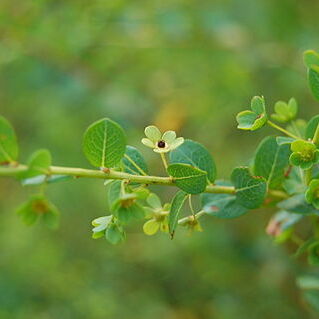Male flowers: sepals 5(6), free or almost so, imbricate; petals 5(6), shorter than or equalling the sepals; disk glands 5(6) or 10(12), free, opposite the petals, often 2-lobed, or disk cupular, dentate; stamens 5(6), opposite the sepals, filaments free or connate to halfway, anthers erect and introrse, thecae parallel, distinct, longitudinally dehiscent; pistillode trifid, the arms capitate.
Female flowers: sepals larger than in the male; petals smaller, minute or 0; disk glands as in the male; ovary 3-locular, ovules 2 per locule, hemitropous; styles 3, short, bifid or bipartite, stigmas capitate.
Seeds 2 per locule, segmentiform, triquetrous or trigonous, smooth, sculptured or ornamented, ecarunculate; albumen fleshy; embryo curved, radicle long, cotyledons broad, flat.
Fruit globose or subglobose, 3-lobed, dehiscing into 3 bivalved cocci; endocarp thinly woody; columella small, persistent.
Leaves alternate, petiolate, stipulate, simple, entire, penninerved, often small.
Flowers axillary, pedicellate, males often fasciculate, females solitary.
Monoecious perennial herbs or subshrubs.
Indumentum simple, glandular, or absent.

